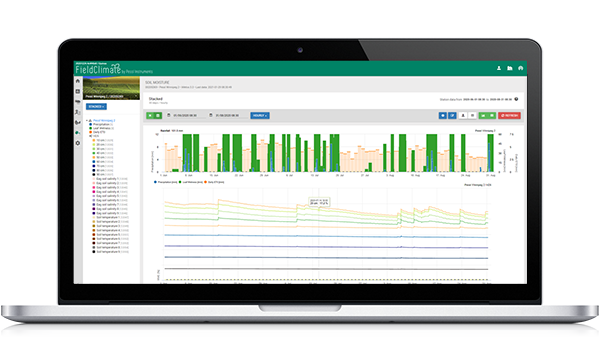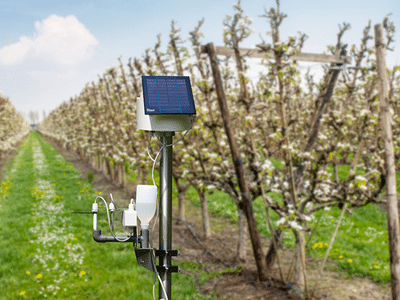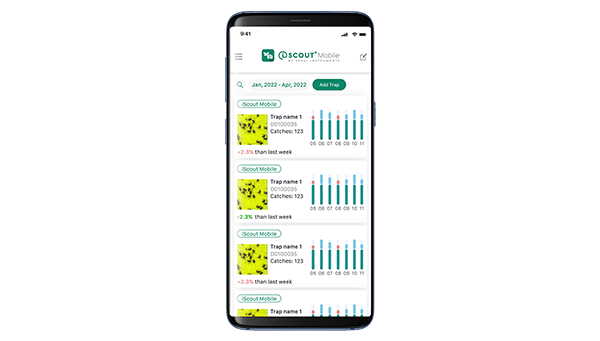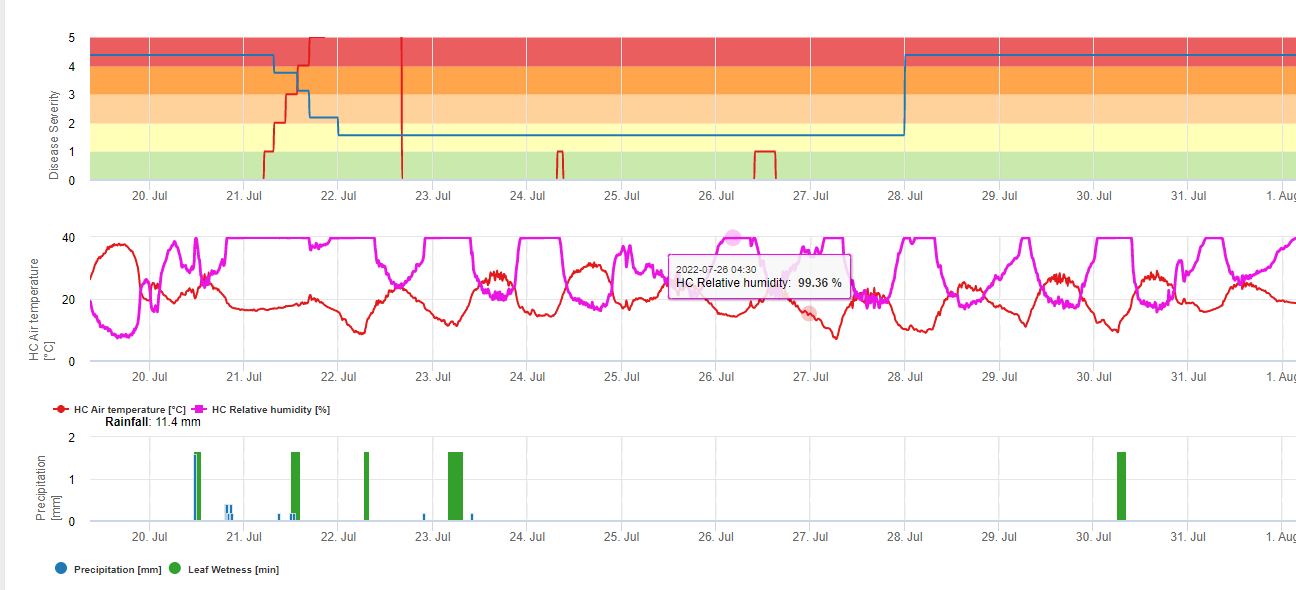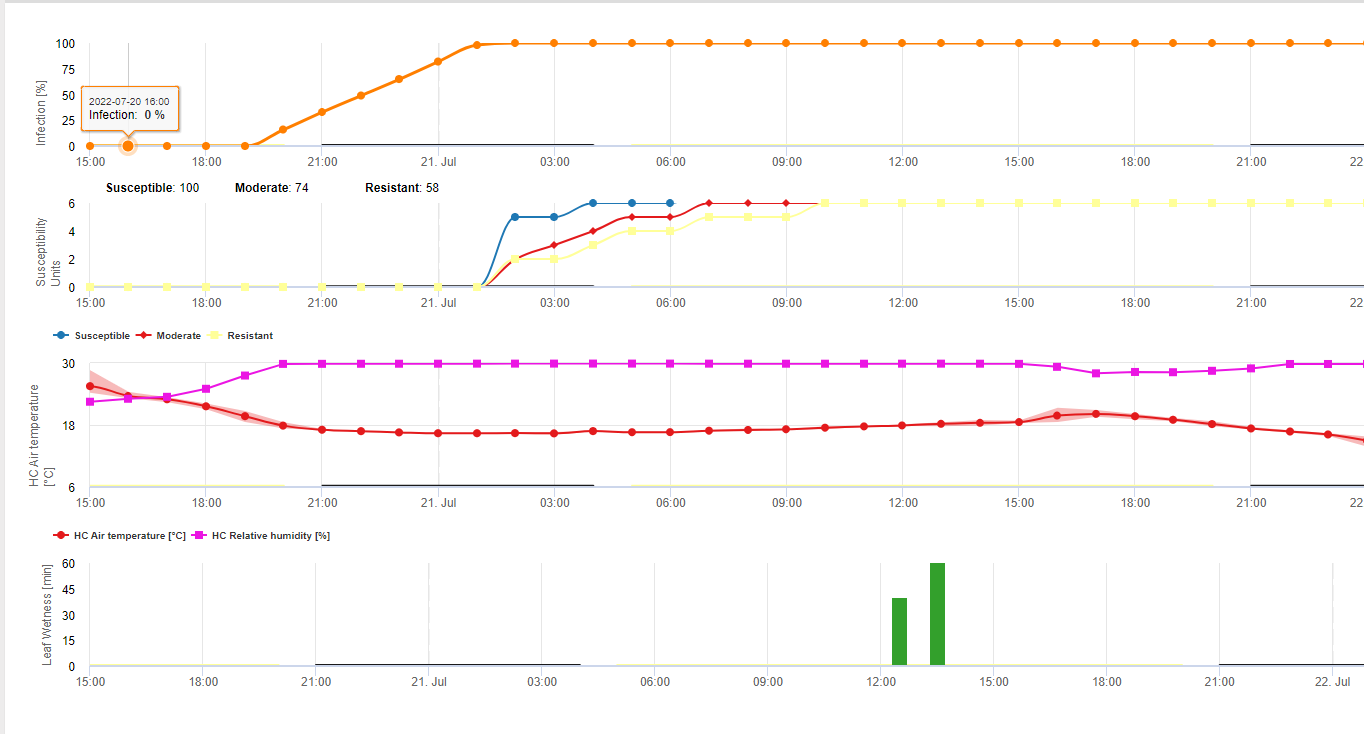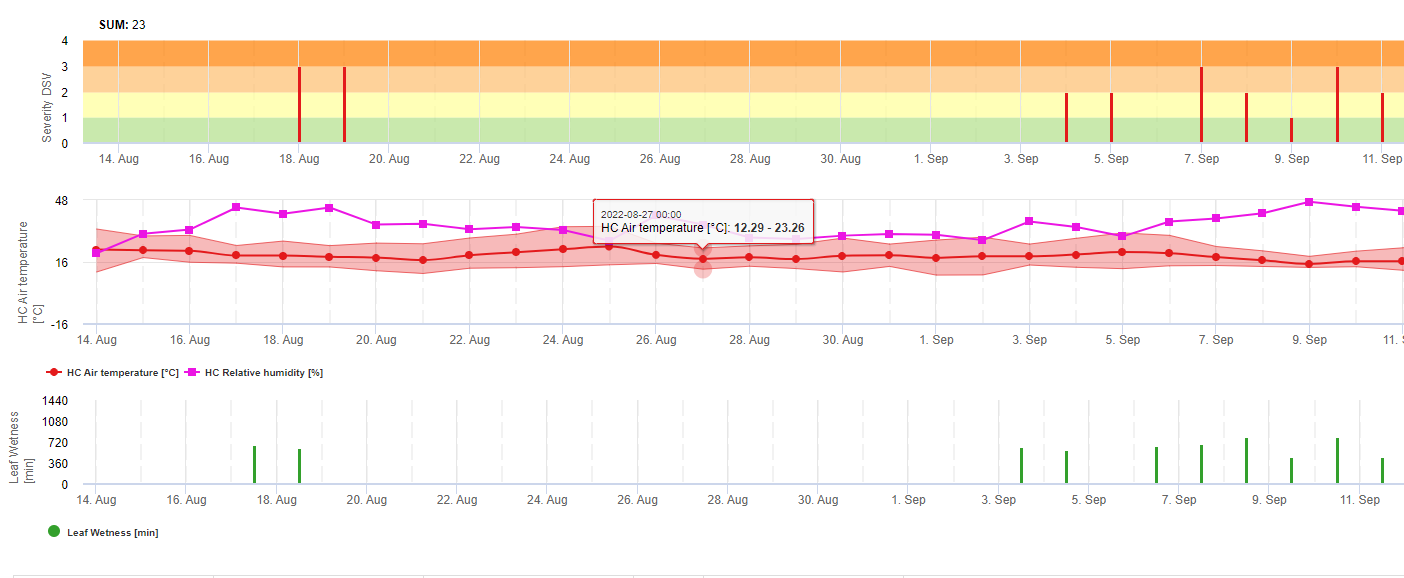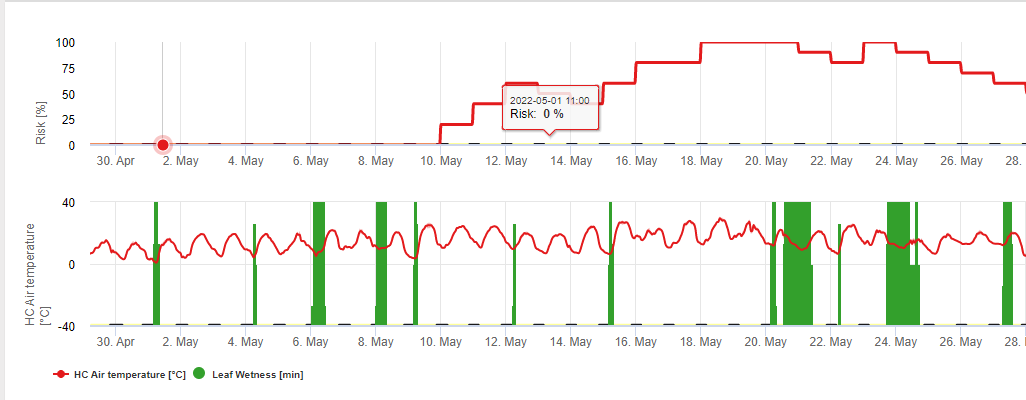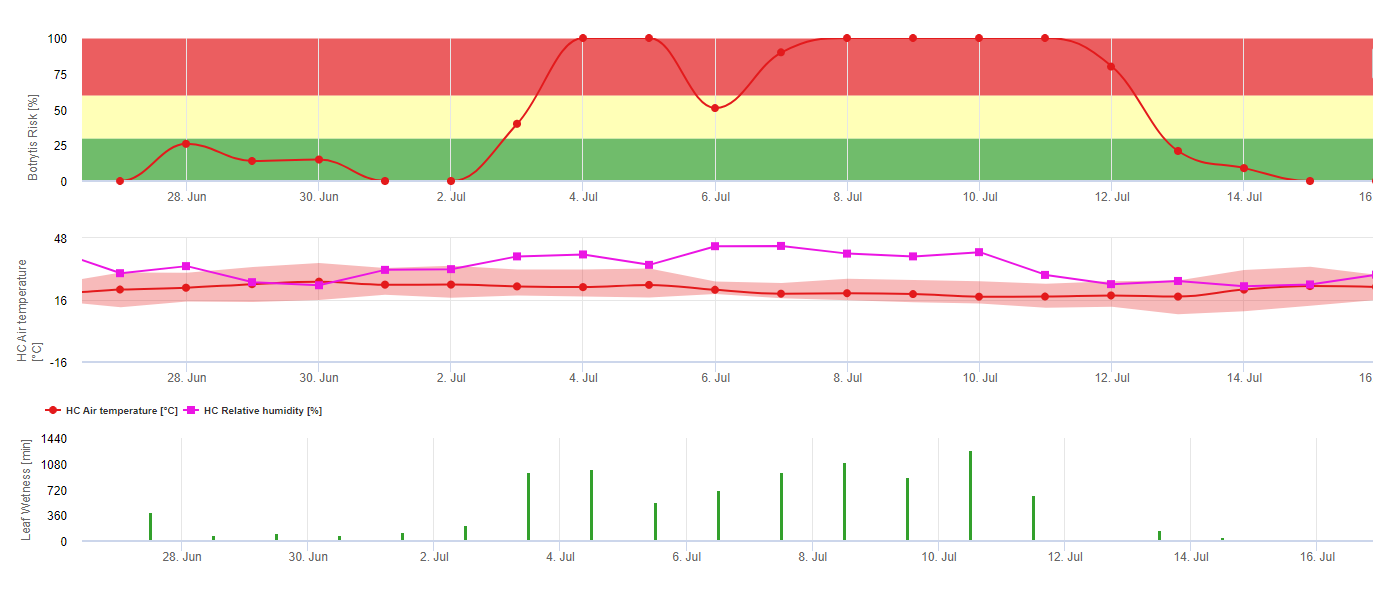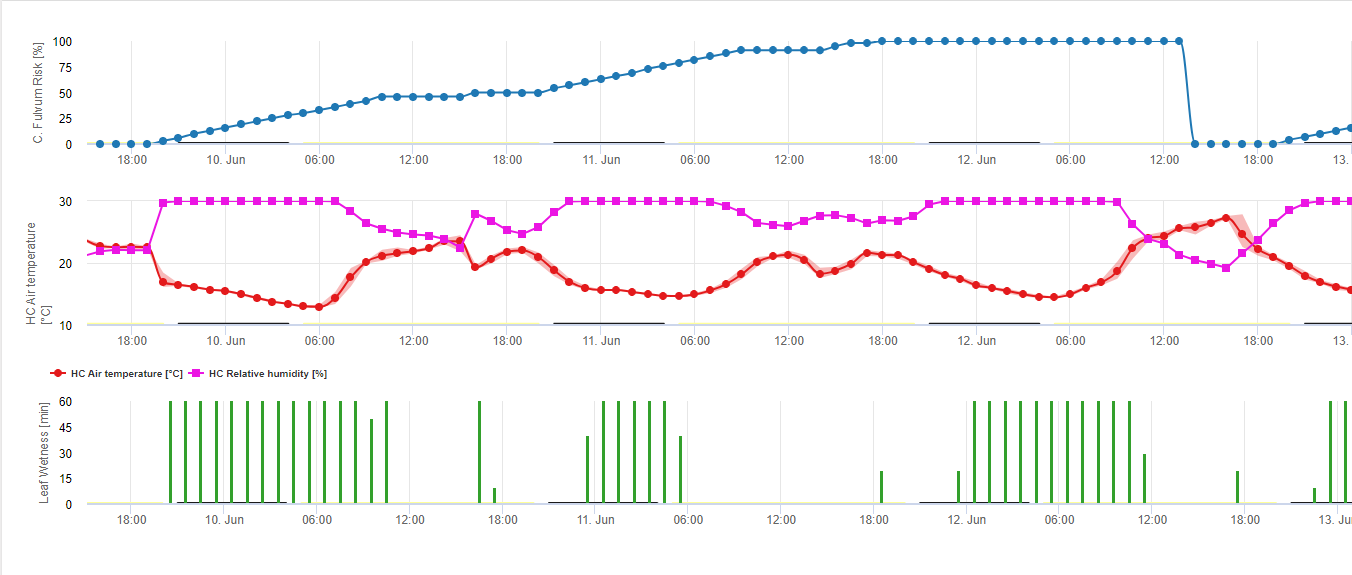

Tomato disease models
Late blight
Tomato Late Blight caused by Phytophthora infestans is one of the most devastating plant diseases. It has led to starvings and emigration when it came to Europe. It is one of the most important diseases and therefore numerous models are available for it. P. infestans is a obligate parasite. It can only live in the green tissue of its hosts. The economic important plants under its hosts are potato, tomato and egg plant. In the cool climate during winter the pathogen will find no green tissue and it has to hibernate in infected tubers or in its fruiting bodies the oospores. Oospores will only be formed in places where two different mating types of P. infestans are present. This is reported for Europe since the last 25 years. Still of greater importance is the hibernation in infected tubers left as volunteers on the field because of undersize or other reasons or damped on the field as waste form potato storage.
Newer laboratory methods enabled us to check for latent infected tubers in the potato seed. This showed that we have to expect this in the potato seed. The quantities with which we have to expect latent infected seeds is depending on the blight epidemics of the last season in the seed producing area.
P. infestans growth like other oomycetes in the intercellular area of its hosts. Systemic growth is enforced by high relative humidity and by high soil water content or low soil oxygen content. Plants formed by latent or symptomous infected tubers show extended systemic growth in periods with water logging. In the morning during and after such periods you will find potato sprouts covered by white sporangia. Sporangia in oomycetes are formed in the absence of light if relative humidity and temperature are high enough. For P. infestans sporangia formation will take place in nights with relative humidity higher than 90% and temperatures warmer than 10°C. Sporangia can be distributed by rain or wind.
In literature we can find informations about sporandia germinating and infecting like conidia. Sporanigia in oomycetes usally germinating with zoospores which are mobile in free water. The zoospores are swimming to stoma trough which its infects its host. Jim Deacon from Institute of Cell and Molecular Biology, University of Edinburgh, found that at temperatures of 12°C and lower the majority of sporangia releases zoospores whereas at temperatures higher than 20°C the majority of the sporangia germinates like conidia with germ tubes. Therefore infection of P. infestans in cool climate is most likely limited by the presence of free moisture which can be given by dew in nights which have more than 90% relative humidity needed for sporangia formation. More sever infections have to be expected with rain distributing the zoospores over the potato field and leading to an exponential increase in infected plants.
In heavily infected plants the pathogen will grow systemic into all plant organs including the tubers. In situations with severe disease pressure the potato leaf has to be killed with herbicide to avoid the infections of the tuber.
In FieldClimate the models NOBLIGHT and FRY are implemented
The IPI Model
The IPI model displays a negative prognosis, which has been developed by BUGIANI, CAVANNI, I. PONTI for the Emilia-Romagna region in Italy. It is used to estimate the date of the first spray against this disease in tomato.
Model Description: This model generates infection potential indexes (IPI) that predict the most probable inoculum increase of Phytophthora infestans in the environment. In Italy, IP indexes are used along with indicator plants plus spore traps to warn farmers about when to start spraying. The model does not give recommendations about subsequent fungicide applications. Negative prognosis can´t be used in areas with permanent cropping, areas with no winter.
Functionality: To calculate daily IPI,relative indexes for average temperature and relative humidity and precipitation are calculated independently and combined by multiplying the temperature index by either the precipitation index or the relative humidity index. The cumulative daily IPI over a defined period is used by the model to evaluate late blight risk. The IPI-Model is used as a negative prognosis in Italy. At the time the IPI-Value comes over 15 they start to spray against Late Blight in tomato. As long as it stays below no spray is indicated.
Result: FieldClimate displays a steady increasing value for the IPI-Value. µLink displays a steady increasing line. At the time the IPI-Value reaches 18 a qualitative line is displayed in the bottom of the graph.
FieldClimate stops this calculation if temperature stays below 11°C for 96 hours. It starts the calculation again if temperature never falls below 6°C within 96 hours. The maximum value of this calculation is 40. To calculate daily IPI, relative indexes for average temperature and relative humidity and precipitation are calculated independently and combined by multiplying the temperature index by either the precipitation index or the relative humidity index. IPI only needs to be calculated when days have a minimum temperature higher than 7°C, an average temperature between 9 °C and 25°C and more than 0.2 mm of rain or an average relative humidity of more than 80%. Favourable weather conditions for Phytophthora infestans produce a positive IPI. Functions for index calculations are following the graphs beside.
The IPI model for Tomato Late Blight is a negative prognosis model. It is only helpful in areas where we have no permanent cropping of tomato. This means in areas with frost during winter. In such areas Phytophtora infestans inoculum potential is reduced during winter and has to build up in spring again. The IPI model indicates the build up of inoculum in field. If the IPI value reaches 15 the first spray is indicated in the area the model has been developed. If you use the area in another area please check if this value is valid for you.
The Negative Prognosis
The use of a negative prognosis means not to spray as long the prognosis answers the question about the presence of the pathogen in field with NO. This explains the term negative prognosis. The Schrödter and Ullrich Negativ prognosis have been published in the year 1972. It uses temperature, leaf wetness or high relative humidity and rain to assess the propagation of the pathogen in the field. A value in between 0 and 400 is indicating the propagation of P. infestans in the field. This value increases if air temperature is in between 15°C and 20°C, if relative humidity is higher then 70%. It increases faster for all times if relative humidity is higher than 90% and there is precipitation or if there is leaf wetness for more than 4 hours. If this situation is for longer than than 10 hours the increase is higher.
Thresholds: Schrödter and Ullrich are defining a value of 150 to correspond with a disease incidence in the field of 0.1%. A value of 250 corresponds with a disease incidence of 1%. They suggest that after a year with a low pressure of late blight in the seed producing area no sprays are needed before a value of 250 is reached. If a higher amount of inoculum has to be assumed sprays should start at 150.
Whereas the original model defines the start of calculation with the emergence in the specific field, we changed the start of calculation to a temperature based rule making sure that we calculate as soon as the first possible tomato will grow. We will calculate as soon as temperature from 10:00 to 18:00 is higher than 8°C and night temperature is never below 2°C.
The negative prognosis has been used very successful starting form 1972 until the nineties of the last century. This has been the time before we could find resistance against Metalaxyl. The first spray in this years was usually done by Metalxyl and with this the field could be cleared up from P. infestans. Now big areas have resistance against this compound and we do not have any fungicide showing a similar clearing up effect.
In areas where covered potato is grown beside of open field potato we suggest to start spraying as soon as the plastic is removed from the covered crop. The disease can develop under the plastic and the covered crop will become an inoculum source after uncover.
P. infestans grows systemic inside the sprout. This is important if we have latent infected seed. The systemic growth is much favoured by water over saturated soil. To be able to receive information over water saturation of the soil we suggest the use of Watermark sensors. Watermarks are very economic and very helpful for potato irrigation. If we have a period of several hours after emergence where the water tension of the watermark sensor is below 10 cBar (100mBar) and more than 10°C air temperature we have to assume good conditions for systemic growth of the pathogen and we have to start with the sprays against late blight. The NoBlight model:Severity Values are determined, according to the model of Maine (By Steven B. Johnson, Ph.D., Extension crops specialist).
Source: http://umaine.edu/publications/2418e/#table
The FRY Model
W.E.FRY (1983) published his work done on infection of potatoes with different susceptibility levels at different durations of relative humidity higher than 90% or leaf wetness and temperatures. Derived from this results he developed an infection model for late blight in potato and in the next step a model to estimate the propriety spray interval for the fungicide cloranthonil (Bravo).
Susceptible cultivars can be infected within shorter moist periods and the disease severity will be higher. Whereas moderate susceptible and resistant varieties will need a longer moist period or warmer temperatures to be infected and the disease severity is lower.
For susceptible varieties the maximum rating of an infection period can be 7 whereas for moderate susceptible varieties it can be 6 and for resistant varieties it can be 5 only. In the same way the assessment of the spray interval is asking again for the level of susceptibility of the cultivar. A spray is needed if the last spray is longer than 6 days away and the accumulated blight Units are exceeding: 30 for susceptible varieties, 35 for moderate susceptible varieties and 40 for moderate resistant varieties.
This model is very useful to estimate if a new spray is needed. We can start to accumulate the fry units from the date of the last spray on. If the accumulated value excites the threshold we will have to spray again. Fry, WE, AE Apple & JA Bruhn (1983). Evaluation of potato late blight forecasts modified to incorporate host resistance and fungicide weathering. Phytopathology 73:1054-1059.
Early blight
Early Blight of Potato and Tomato
Randall C. Rowe, Sally A. Miller, Richard M. Riedel, Ohio State University Extension Service
Early blight is a very common disease of both potato and tomato. It causes leaf spots and tuber blight on potato, and leaf spots, fruit rot and stem lesions on tomato. The disease can occur over a wide range of climatic conditions and can be very destructive if left uncontrolled, often resulting in complete defoliation of plants. In contrast to the name, it rarely develops early, but usually appears on mature foliage.
Symptoms
On leaves of both crops, the first symptoms usually appear on older leaves and consist of small, irregular, dark brown to black, dead spots ranging in size from a pinpoint to 1/2 inch in diameter. As the spots enlarge, concentric rings may form as a result of irregular growth patterns by the organism in the leaf tissue. This gives the lesion a characteristic “target-spot” or “bull’s eye” appearance. There is often a narrow, yellow halo around each spot and lesions are usually bordered by veins. When spots are numerous, they may grow together, causing infected leaves to turn yellow and die. Usually the oldest leaves become infected first and they dry up and drop from the plant as the disease progresses up the main stem.
On tomato, stem infections can occur at any age resulting in small, dark, slightly sunken areas that enlarge to form circular or elongated spots with lighter-coloured centers. Concentric markings, similar to those on leaves, often develop on stem lesions. If infested seed are used to start tomato transplants, seedlings may damp off soon after emergence. When large lesions develop at the ground line on stems of transplants or seedlings, the plants may become girdled, a condition known as “collar rot.” Such plants may die when set in the field or, if stems are weakened, may break over early in the season. Some plants may survive with reduced root systems if portions of stems above the canker develop roots where they contact the soil. Such plants, however, usually produce few or no fruits. Stem lesions are much less common and destructive on potato.
Blossom drop and spotting of fruit stems, along with loss of young fruit, may occur when early blight attacks tomatoes in the flowering stage. On older fruits, early blight causes dark, leathery sunken spots, usually at the point of stem attachment. These spots may enlarge to involve the entire upper portion of the fruit, often showing concentric markings like those on leaves. Affected areas may be covered with velvety black masses of spores. Fruits can also be infected in the green or ripe stage through growth cracks and other wounds. Infected fruits often drop before they reach maturity.
On potato tubers, early blight results in surface lesions that appear a little darker than adjacent healthy skin. Lesions are usually slightly sunken, circular or irregular, and vary in size up to 3/4 inch in diameter. There is usually a well defined and sometimes slightly raised margin between healthy and diseased tissue. Internally, the tissue shows a brown to black corky, dry rot, usually not more than 1/4 to 3/8 inch deep. Deep cracks may form in older lesions. Tuber infection is uncommon under Ohio conditions.
Pathogen
Early blight is caused by the fungus, Alternaria solani, which survives in infected leaf or stem tissues on or in the soil. This fungus is universally present in fields where these crops have been grown. It can also be carried on tomato seed and in potato tubers. Spores form on infested plant debris at the soil surface or on active lesions over a fairly wide temperature range, especially under alternating wet and dry conditions. They are easily carried by air currents, windblown soil, splashing rain, and irrigation water. Infection of susceptible leaf or stem tissues occurs in warm, humid weather with heavy dews or rain. Early blight can develop quite rapidly in mid to late season and is more severe when plants are stressed by poor nutrition, drought, or other pests. Infection of potato tubers occurs through natural openings on the skin or through injuries. Tubers may come in contact with spores during harvest and lesions may continue to develop in storage.
Background
TOMCAST (TOMato disease foreCASTing) is a computer model based on field data that attempts to predict fungal disease development, namely Early Blight, Septoria Leaf Spot and Anthracnose on tomatoes. Field placed data loggers are recording hourly leaf wetness and temperature data. This data where analysed over a 24 hour period and may result in the formation of a Disease Severity Value (DSV); essentially an increment of disease development. As DSV accumulate, disease pressure continues to build on the crop. When the number of accumulated DSV exceed the spray interval, a fungicide application is recommended to relieve the disease pressure.
TomCast
Timing fungicide applications for early blight, Septoria leaf spot, and Anthracnose
A system of weather-based disease forecasting called TOMCAST, developed by Dr. Ron Pitblado at the Ridgetown College of Agricultural Technology in Ontario, Canada, can be used to time fungicide applications for three fungal diseases; early blight (caused by Alternaria solani), Septoria leaf spot (caused by Septoria lycopersici), and fruit anthracnose (caused by Colletotrichum coccodes). If late blight is present in your county or adjacent counties, or conditions are present for movement of spores into your area, use the Simcast late blight forecast system to time fungicide applications.
IMPORTANT CAUTIONARY NOTE:
TOMCAST is not useful on farms that have a history of bacterial diseases. If you commonly have problems with bacterial spot, speck, or canker in your tomatoes, you should not use TOMCAST because the recommended spray intervals will not be sufficient for control of bacterial diseases if you’re tank-mixing copper with your fungicide applications. Find information about reducing bacterial diseases here: http://extension.psu.edu/plants/vegetable-fruit/news/2015/farming-like-you-expect-bacterial-diseases
TOMCAST uses leaf wetness and temperature data to calculate disease severity values (DSV’s) as shown in Table 1.
TOMCAST is derived from the original F.A.S.T. (Forecasting Alternaria solani on Tomatoes) model developed by Drs. Madden, Pennypacker, and MacNab ? at Pennsylvania State University (PSU). The PSU F.A.S.T. model was further modified by Dr. Pitblado at the Ridgetown College in Ontario into what we now recognize as the TOMCAST model used by Ohio State University Extension.
DSV are A Disease Severity Value (DSV) is the unit of measure given to a specific increment of disease (early blight) development. In other words, a DSV is a numerical representation of how fast or slow disease (early blight) is accumulating in a tomato field. The DSV is determined by two factors; leaf wetness and temperature during the “leaf wet” hours. As the number of leaf wet hours and temperature increases, DSV accumulate at a faster rate. See the Disease Severity Value Chart below.
Conversely, when there are fewer leaf wet hours and the temperature is lower, DSV accumulate slowly if at all. When the total number of accumulated DSV exceeds a preset limit, called the spray interval or threshold, a fungicide spray is recommended to protect the foliage and fruit from disease development.
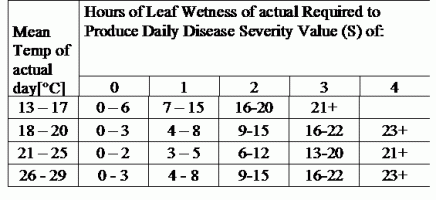

The spray interval (which determines when you should spray) can range between 15-20 DSV. The exact DSV a grower should use is usually supplied by the processor and depends on the fruit quality and end use of the tomatoes. Following a 15 DSV spray interval is a conservative use of the TOMCAST system, meaning you will spray more often than a grower who uses a 19 DSV spray interval with the TOMCAST system. The trade off is in the number of sprays applied during the season and the potential for difference in fruit quality.
USING TOMCAST: Tomatoes grown within 10 miles of a reporting station should benefit from the disease management function of TOMCAST to help forecast early blight, Septoria, and Anthracnose. If you decide to try TOMCAST this season please keep in mind three very important concepts.
One: If this is your first time using the system, it is recommended that only part of your acreage be put into the program to see how it fits with your quality standards and operational style.
Two: Use TOMCAST as a guide to help better time fungicide applications, realizing in some seasons you may actually apply more product than a set schedule program might require.
Three: The further a tomato field is from a reporting site increases the likelihood of distortion in the DSV accumulation, i.e., the reported value may be a few DSV higher or lower than that experienced by the field location. This should be taken into consideration when application of fungicides is likely a few days away. Listen to the DSV reports of nearby stations and triangulate to your own location as the best way to roughly estimate your DSV accumulation.
FIRST SPRAY USING TOMCAST:There has been some discussion over the years regarding the application of the first spray when following TOMCAST. The rule stated in the 1997 Vegetable Production Guide centers around the planting date.
Tomato plants that enter the field before May 20 should have the first spray applied when DSV for that area exceed 25 or when a fail safe date of June 15 arrives. The fail safe is used only if you have not treated since May 20, and is a means to eliminate initial disease inoculum. After the first spray, these tomatoes are subsequently treated when the chosen spray interval (range 15-20 DSV) is exceeded.
Tomatoes planted after May 20 are treated when they exceed the chosen spray interval (range 15-20 DSV) or when they have not been treated by the fail safe date of June 15. Therefore, it is critical to compare the tomato planting date to the date DSV reporting began in that area to guide the spray decision process.
Powdery mildew
Tomato powdery mildew may be caused by three pathogens worldwide.
Leveillula taurica (Oidiopsis taurica) is a pathogen of a wide range of host species in warm arid to semiarid climates in Asia, the Mediterranean, Africa, and more recently the southwest United States.
Erysiphe orontii (E. cichoracearum and E. polyphaga) is another species common to many host plants in both temperate and tropical regions.
And as a third species Odium lycopersicum.
Factors for Disease Development:
• relative humidity levels > 50% (optimum RH > 90%)
• free water on leaf surfaces is not necessary
• temperature range: 10-35 °C (best below 30 °C)
Powdery mildew is an inoculum driven disease. Therefore just risky periods could be determined, main factor for the damage, e.g. the outbreak is the initial inoculum (which is active in a broad range of temperature). So for control strategies: combine the modeling of the risky period together with the monitoring of fungal inoculum (disease) in the field!
Open Field Tomato
Grey mould
Grey mould (Botrytis cinerea) overwinters as sclerotia or as mycelium in plant debris and may be seedborne as spores or mycelium in a few crops. Other crops may also serve as sources of the pathogen and are likely to cross-infect. Conidia are airborne and may also be carried on the surface of splashing rain drops. High relative humidity is necessary for prolific spore production. In the field, spores landing on tomato plants germinate and produce an infection when free water from rain, dew, fog, or irrigation occurs on the plant surface.
Optimum temperatures for infection are between 18° and 24° C, and infection can occur within 5 hours. High temperatures, above 28° C, suppress growth and spore production. Dying flowers are a favorable site for infection, but infections can also result from direct contact with moist infested soil or plant debris. In the greenhouse, stem lesions develop either by direct colonization of wounds or through infected leaves. The presence of external nutrients, such as pollen grains in the infection droplet, can markedly increase infection. The type of wound is said to influence stem lesion development; breaking off leaves is reported to give a lower incidence of stem lesions than cutting off leaves with a knife, leaving a stub.
FieldClimate is indicating the risk of a Botrytis cinerea infection on base of leaf wetness periods and the temperature. The graph below shows the duration of wet leaves in dependence of the actual temperature needed for a Botrytis infection. If the risk is higher than 0 every leaf wetness period longer than 4 hours will increase the risk by the same relation. A day with a leaf wetness period shorter than 4 hours is assumed to be a dry day and will reduce the risk by 20% of the actual value.
The graph shows the correlation between duration of leaf wetness and temperature leading to a risk of 30% of a B.cinerea infection.
FieldClimate: Botrytis risk calculated from temperature and leaf wetness period, measured on the station.The FieldClimate Botrytis Risk Model results in a risk value of 0 to 100%. This value indicates the pressure of B. cinerea at the time. If we have a value of 100%it means that there has been several times a wetness period long enough to infect the susceptible tissue(we calculate so called “wet points” (array between leaf wetness, temperature with a maximum of initially 38400 points (beginning of season, which displays 30% risk). After this period each wet period with about 4000 wet points (array) increase the risk with 10% or on the other side each dry period reduce the risk by 1/5 of the former value. An application against B. cinerea is depending on the fruit and the production target.
Leaf spot
Text from: T. A. Zitter, Department of Plant Pathology, Cornell University ; Fact Sheet Page: 735.80 Date:12-1987.
Septoria leaf spot of tomato caused by the fungus Septoria lycopersici occurs on tomatoes worldwide. The fungus infects only solanaceous plants, of which tomato is the most important. Tomatoes may often be infected with leaf spot and early blight (Altemaria solani) simultaneously, but the two diseases can be distinguished readily and the control measures are similar.
Symptoms
Septoria leaf spot can occur at any stage of plant development. Symptoms may appear on young greenhouse seedlings ready for transplanting or be first observed on the lower, older leaves and stems when fruits are setting. The timing of symptom appearance can be correlated with the sources of inoculum and environmental factors and will be discussed later. Small, water-soaked circular spots 1 .6 to 3.2 mm in diameter first appear on the undersides of older leaves. The centers of the spots are gray or tan and spots have a dark brown margin. As the spots mature, they enlarge to about 6,4 mm in diameter and may coalesce. In the center of the spots are many dark brown, pimple-like structures called pycnidia-fruiting bodies of the fungus. The structures are large enough to be seen with the unaided eye or with the aid of a hand lens. Pycinidia are absent from early blight lesions and from lesions produced by the gray leaf fungus, Stemphylium solani, which is common in areas with consistent warm and humid conditions. Septoria leaf spot also lacks the target-like lesions so typical for Altemaria blight. Spots may also appear on stems, calyxes, and blossoms, but rarely on fruit. Heavily infected leaves will turn yellow, dry up, and drop off. This defoliation will result in sunscalding of the fruit.
Epidemiology
Under wet conditions, numerous spores (conida) are produced in the pycnidia and are exuded when the fruiting structures are mature. The temperature range for sporulation varies from 15° to 27°C with 25°C being optimal. Spores may be spread by windblown water, splashing rain, hands and clothing of pickers, insects such as beetles, and cultivation equipment. Following spread, spores may germinate within 48 hr under moist conditions and favorable temperatures. Leaf spots can appear within 5 days, pycnidia appear within 7-10 days, and spore production is repeated within 10-13 days. Because free moisture is necessary for spore infection through stomates, long-lasting dew and rainy days (100 percent RH for 48 hr accumulated over several days) favor disease development. Although the fungus is not a soil inhabitant, it can persist from one season to the next on debris of diseased plants incorporated in the soil (most commonly in the field but occasionally in the greenhouse). The pathogen can also overwinter on solanaceous weeds. Susceptible weeds include: jimsonweed (Datura stramonium), an annual reproducing by seed horsenettle (Solanum carolinense), a perennial reproducing by seed and rhizomes; smooth groundcherry (Physalis subglabrata), a perennial reproducing by rhizomes and seed; and black nightshade (Solanum nigrum), an annual reproducing by seed. Crops infected are potato and eggplant in addition to tomato. Tomato seed has been shown to carry spores and produce infected seedlings, but whether the pathogen is truly seedborne is unknown.
Anthracnose fruit rot
Several species of plant pathogenic fungi in the genus Colletotrichum cause anthracnose in peppers and many other vegetables and fruits. Until the late 1990s, anthracnose of peppers and tomatoes was only associated with ripe or ripening fruit. Since that time, a more aggressive form of the disease has become established. This form attacks peppers at any stage of fruit development and may threaten the profitability of pepper crops in areas where it becomes established. This disease can also affect tomatoes, strawberries, and possibly other fruit and vegetable crops.
Symptoms
Circular or angular sunken lesions develop on immature fruit of any size. Often multiple lesions form on individual fruit. When disease is severe, lesions may coalesce. Often pink to orange masses of fungal spores form in concentric rings on the surface of the lesions. In older lesions, black structures called acervuli may be observed. With a hand lens, these look like small black dots; under a microscope they look like tufts of tiny black hairs. The pathogen forms spores quickly and profusely and can spread rapidly throughout a pepper crop, resulting in up to 100% yield loss. Lesions may also appear on stems and leaves as irregularly shaped brown spots with dark brown edges.
Pathogen
This form of pepper anthracnose is caused by the fungus Colletotrichum acutatum. The pathogen survives on plant debris from infected crops and on other susceptible plant species. The fungus is not soil-borne for long periods in the absence of infested plant debris. The fungus may also be introduced into a crop on infested seed. During warm and wet periods, spores are splashed by rain or irrigation water from diseased to healthy fruit. Diseased fruit act as a source of inoculum, allowing the disease to spread from plant to plant within the field. The fungus survives in and on seeds. Anthracnose is introduced into the field on infected transplants or it can survive between seasons in plant debris or on weed hosts. Alternative hosts include weeds and other plants in Solanaceae (tomato, potato, eggplant) although infections of these hosts are extremely rare in Florida. Fruit are infected when spores of the fungus or infested debris is rain splashed onto pepper plants. New spores are produced within the infected tissue and then are dispersed to other fruit. Workers may also move spores with equipment or during handling of infected plants. Infection usually occurs during warm, wet weather. Temperatures around 80° F (27° C) are optimum temperatures for disease development, although infection occurs at both higher and lower temperatures. Severe losses occur during rainy weather because the spores are washed or splashed to other fruit resulting in more infections. The disease is more likely to develop on mature fruit that is present for a long period on the plant, although it can occur on both immature and mature fruit. Anthracnose can infect from 15 °C to 30°C. But a long leaf wetness is needed to fullfil the needs for an infection. At optimum temperature from 20°C to 25°C still 12 hours of leaf wetness are needed. Higher or cooler temperature will need even longer leaf weetness periods (no linear function/array needed for calculation). FieldClimate calculates the possilbe infection events on base of leaf wetness and the temperatures during this event.
Leaf mould
Leaf mold, caused by the pathogen Fulvia fulva (Cladosporium fulvum), is primarily a disease of greenhouse tomatoesalthough it can occur in the field during cool, humid conditions. Most serious under humid greenhouse conditions and in poorl ventilated plastic houses, the fungus infects plants grown in soil as well as in hydroponic production. Tomato is the only plant affected by this disease. The actual relationship between disease severity and yield loss is still unclear. However, in one study, significant decreases in yield were detected 6 weeks after 50% of the foliage was symptomatic.
The pathogen survives in the tomato field:
• as a saprophyte on crop residue or as conidia or sclerotia in soil;
• as conidia or spores (can survive at least one year without a host or under adverse conditions);
• as a contaminant of seed.
Symptoms
Symptoms usually only occur on the foliage. Older leaves are infected first and the fungus moves progressively up the plant on the younger leaves. Initial leaf symptoms appear as pale yellow or green areas or spots with indefinite margins. These are often first visible on the upper leaf surface. When infection is severe, these spots can coalesce and the entire leaf is killed. Diagnostic symptoms develop on the lower leaf surface when the fungus sporulates and gives the infected area an olive-green, velvety appearance. Infected leaves eventually brown, curl, wither, and drop prematurely. Defoliation gradually progresses up the plant as the fungus spreads to younger leaves. Symptoms can occasionally develop on petioles, stems, peduncles, blossoms, and fruit. Infected blossoms are usually killed before fruit set. Green and ripe fruit can be infected and develop a dark, leathery rot on the stem end. Infected fruit may also be lopsided and have blackened furrows.
Climatic conditions for Disease Development:
• relative humidity levels >85%
• free water on leaf surfaces
• optimum temperature: 22-24 °C (germination occurs 5-35 °C)
In FieldClimate we determine the risk of a Cladosporium fulvum infection by leaf wetness, relativ humidity and air temperature parameters. The graph shows an infection of tomatoes on the 22th of April.
Phytophthora blight
Phytophthora blight of pepper is caused by the fungus Phytophthora capsici. Other names applied to this disease of peppers are damping off and Phytophthora root rot, crown rot, and stem and fruit rot. All of these names can apply since all parts of the pepper plant are affected. The disease has been responsible for serious losses. Other crops infected have included eggplant, tomato, summer and winter squash, and pumpkin. Other reported hosts include cucumber, watermelon, and honeydew melon. The pathogen involved in these latter crops may be Phytophthora parasitica or P. capsici. Phytophthora blight of peppers can attack the roots, stems, leaves, and fruit, depending upon which stage plants are infected. A grower not knowing what to expect might first encounter the disease at mid-season when sudden wilting and death occur as plants reach the fruiting stage. Early infected plants are quickly killed, while later-infected plants show irreversible wilt. Often a number of plants in a row or in a roughly circular pattern will show these symptoms at the same time. Fungus-infected seedlings will damp off at the soil line, but relatively few plants die when temperatures are cool. Far more commonly, the disease will strike older plants which then exhibit early wilting. Stem lesions can occur at the soil line and at any level on the stem. Stems discolor internally, collapse, and may become woody in time. Lesions may girdle the stem, leading to wilt above the lesion, or plants may wilt and die because the fungus has invaded the top branches before the stem lesions are severe enough to cause collapse.
P. capsici reproduces most rapidly in warm and wet or humid weather by producing millions of short-lived, lemon-shaped spores on the surface of infected plants. These spores can be splashed from the soil to plants, or between plants, and they can also be carried by moving water in a field. Each one can also release 20-40 mobile spores that can swim short distances through standing water or saturated soil towards plant roots. Both of these spores can be produced very rapidly, and only require the presence of a single isolate of P. capsici. A second type of spore with much thicker walls is produced inside infected plant tissue, and requires the presence of at least two isolates of P. capsici. All P. capsici isolates can be classified as either A1 or A2 isolates, and these thick-walled spores are only produced when A1 and A2 isolates grow close to each other. Although these spores are produced more slowly, they are very important to the life cycle of Phytophthora blight because they can survive for years in the soil until a susceptible crop is planted. For this reason, once these thick-walled spores are in the soil Phytophthora blight is there to stay. In FieldClimate we calculate the formation and infection by Oospores (sexual) and the formation and infection by Sporangia (asexual). Oospores need the presence of two isolates of P. capsici, are thick walled inside the plant tissue and are able to survive a long time periode, while sporangia are the asexual form, which are dispersed quickly.
Leaves first show small dark green spots that enlarge and become bleached, as though scalded. If the plant stems are infected, an irreversible wilt of the foliage occurs. Infected fruits initially develop dark, water-soaked patches that become coated with white mold and spores of the fungus. Fruits wither but remain attached to the plant. Seeds will be shriveled and infested by the fungus. Because of the wide host range and the various phases at which plants can be infected, refer to the table for clarification of the crops affected and the Phytophthora species involved.
The symptoms of buckeye rot of tomato consist of leathery tan or brown spots, often appearing as concentric rings or bands on green fruit. Lesions can appear on the shoulder or, more commonly, on the blossom end where the tomato has contact with wet soil. On butternut squash (and on several of the other crops listed with fruit symptoms) tan or brown lesions may give a banding affect or appear as large circular spots. Under humid conditions, white cottony mycelium and spores occur on the surface, and fruit are likely to rot quickly from secondary organisms.
Recommended equipment
Check which sensor set is needed for monitoring this crop’s potential diseases.

